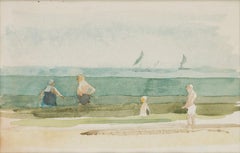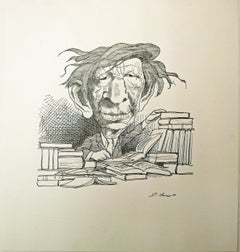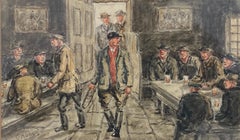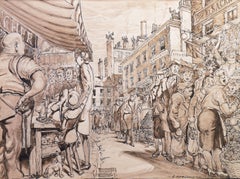David Levine Art
to
3
2
1
3
Overall Height
to
Overall Width
to
3
2
1
1
1
1
1
3
2
1
3
6,997
3,373
2,513
1,212
2
2
2
2
1
Artist: David Levine
Beach Scene
By David Levine
Located in Greenwich, CT
David Levine (1926-2009)
Category
1950s David Levine Art
Materials
Paper, Watercolor, Pencil
Rowing in Central Park
By David Levine
Located in Greenwich, CT
David Levine (1926-2009)
Category
1950s David Levine Art
Materials
Paper, Watercolor, Pencil
W. H. AUDEN
By David Levine
Located in Portland, ME
Levine, David. W. H. AUDEN. Drawing, ink on paper, 1970. Signed "D.
Levine 70, lower right, and inscribed on the verso, "Auden Look July
14, 1970," indicating that this caricature d...
Category
1970s David Levine Art
Materials
Ink
Related Items
“After the Hunt”
Located in Southampton, NY
Original watercolor with graphite tracings of interior pub scene by the British artist, George Anderson Short. Signed bottom left. Circa 1940. ...
Category
1940s Academic David Levine Art
Materials
Watercolor, Archival Paper, Graphite
'The Enduring Attractions of the Open Market', Capitalism Satire
By Antonio Manganaro
Located in Santa Cruz, CA
Signed lower right, 'A. Manganaro' for 'Antonio Manganaro (Italian, 20th Century), and titled lower center, 'The Enduring Attractions of the Open Market'.
Matted Dimensions: 16 x 20
Category
Mid-20th Century Realist David Levine Art
Materials
Gouache, Pen, Graphite, Paper, Ink
St. John the Baptist in the wilderness , Ecce Agnus Dei (Behold the Lamb of God)
By Giovanni Francesco Barbieri (Il Guercino)
Located in Middletown, NY
Pen and sepia ink and wash on vellum, 8 7/8 x 10 1/2 inches (225 x 267 mm). In very good condition with some modern notations in pencil on the verso, minor cockling, and a 1-inch hor...
Category
Mid-17th Century Old Masters David Levine Art
Materials
Ink, Watercolor, Vellum, Pencil
“The Hunter”
Located in Southampton, NY
Original watercolor with graphite tracings of a solitary hunter in the field by the British artist, George Anderson Short. Signed bottom right. ...
Category
1940s Academic David Levine Art
Materials
Watercolor, Archival Paper, Graphite
“British Pub”
Located in Southampton, NY
Original watercolor with graphite tracings of interior crowded pub scene by the British artist, George Anderson Short. Signed lower left and date...
Category
1930s Academic David Levine Art
Materials
Watercolor, Archival Paper, Graphite
City - Mixed Media by N. Czinober - mid 20th Century
By Nicolas Czinober
Located in Roma, IT
City is an original drawing in pencil made by the Hungarian artist Nicolas Czinober in the mid-20th century.The state of preservation is good, the paper presents some small stains.
...
Category
Mid-20th Century Modern David Levine Art
Materials
Charcoal, Paper, Watercolor, Pencil
No Reserve
H 12.6 in W 8.67 in D 0.08 in
The Wimbledon hoax! or Waterloo review!!!
By George Cruikshank
Located in Middletown, NY
A remarkable published sketch replete with primo pensiero; a window into Cruikshank's genius for sociopolitical caricature.
Double-sided preparatory drawing in graphite with watercolor and ink on light-weight cream wove paper, 19 1/4 x 8 7/8 inches (487 x 224 mm), the full sheet. Signed boldly in brown ink, lower right image area. Uniform age tone, marginal wear including some minor areas of edge wear and two very minor associated losses at the lower left sheet edge. Colors appear to be slightly attenuated. There are three tabs of archival tape at the top sheet edge, verso; at right corner, left corner, and center. All condition points are entirely consistent with the age and nature of the paper and media. Multiple inscriptions in ink and graphite in Cruikshank's own hand. A maquette for the engraved image of the same title, used as the frontispiece to The Scourge, xii, published on June 18, 1816, by J. Johnson Cheapside, London. Impressions of the engraving for which this is a study may be found in the collections of the British Museum and the Yale University Library.
Holiday-making 'cits' drive, ride, and walk (right to left) on a dusty road, in the direction of a sign-post (right) pointing 'To Wimbledon' (left); the opposite arm points (right) to Battersea. On the extreme left is the back of a coach, with outside passengers, one with a huge frothing tankard. A fat man trudges between two women, followed by a bloated dog. A 'cit' on a bucking horse follows. Next is a family party: a fat woman...
Category
Early 19th Century English School David Levine Art
Materials
Handmade Paper, Graphite, Watercolor
“British Pub 2”
Located in Southampton, NY
Original watercolor with graphite tracings of interior crowded pub scene by the British artist, George Anderson Short. Signed top left and dated ...
Category
1930s Academic David Levine Art
Materials
Archival Paper, Watercolor, Graphite
“Bringing Home the Game”
Located in Southampton, NY
Original watercolor with graphite tracings of a hunter bring home the fresh game by the British artist, George Anderson Short. Signed top right. ...
Category
1940s Academic David Levine Art
Materials
Watercolor, Archival Paper, Graphite
“The Hunters”
Located in Southampton, NY
Original watercolor with graphite tracings of two hunters in the field by the British artist, George Anderson Short. Signed bottom right. Circa ...
Category
1940s Academic David Levine Art
Materials
Watercolor, Archival Paper, Graphite
'Man Stretching', Paris, Louvre, Académie Chaumière et Etrangères, LACMA, SFAA
By Victor Di Gesu
Located in Santa Cruz, CA
Stamped, verso, with estate stamp for Victor Di Gesu (American, 1914-1988) and created circa 1950.
Winner of the Prix Othon Friesz, Victor di Gesu first attended the Los Angeles Art...
Category
1950s Post-Impressionist David Levine Art
Materials
Graphite, Gouache, Paper
H 16 in W 10.5 in D 0.13 in
'Standing Nude', Paris, Louvre, Académie Chaumière et Etrangères, LACMA, SFAA
By Victor Di Gesu
Located in Santa Cruz, CA
Stamped, verso, with estate stamp for Victor Di Gesu (American, 1914-1988) and created circa 1950.
A bold figural study of a nude in contrapposto, shown posing with drapery and cont...
Category
1950s Post-Impressionist David Levine Art
Materials
Paper, Gouache, Graphite
H 11.75 in W 7.5 in D 0.13 in
Previously Available Items
In Contemplation (Impressionist portrait of a young man)
By David Levine
Located in Wilton Manors, FL
David Levine (1926-2009). In Contemplation, 1955. Oil on panel, 6.5 x 7.5 inches; 10.5 x 11.5 inches framed.. Davis Galleries label affixed en verso. Excellent condition with no damage or restoration. Unsigned.
Biography:
Widely acknowledged as one of the greatest caricaturists of the second half of the 20th century, David Levine was best known for his drawings for the New York Review of Books (which spanned more than 40 years), Esquire, Time magazine and The New Yorker. Awarded numerous prizes for his work, which was reproduced worldwide and influenced a generation of international cartoonists, he was also an accomplished painter in watercolours and oils.
David Julian Levine was born on 20 December 1926 in Brooklyn, New York, the only child of Harry Levine, who ran a small clothing factory specialising in women’s dresses from a loft on Sixth Avenue, and Lena Isaacson, a nurse. Though not an academically strong pupil (“I didn’t do anything in school – I studied volleyball”), he excelled in drawing and wanted to become a comic-book artist like Will Eisner (creator of The Spirit). At the age of nine he won a contest sponsored by Walt Disney to draw the character Goofy and was invited to audition as an animator for the Disney studio in Los Angeles.
However, his parents decided against this and after he left Erasmus Hall High School, Brooklyn, they sent him to study painting at the Tyler School of Fine Arts at Temple University in Philadelphia (1944). After spending his national service (1945-6) in the US Army, serving as a cartographer in Egypt, he returned to complete his degree and take an art teacher’s certificate (1946-9). He then studied with the Abstract Expressionist painter Hans Hoffman at the Eighth Street School of Painting in Manhattan (1949).
Intending to become a professional painter, his first works (mostly watercolours) were scenes of pressers, cutters, fitters, sewing-machine operators and others in his father’s factory and seaside panoramas of bathers at nearby Coney Island. He began to exhibit regularly at the Davis Gallery in New York from 1954 (until 1963), winning four awards for his paintings from the National Academy of Art & Design. In 1958 he and fellow artist Aaron Shikler (whose portrait of John F Kennedy hangs in the White House), formed the Painting Group, which met regularly over the next 50 years to paint life models (US Supreme Court judge Sandra Day O’Connor famously sat for them in 2006).
Failing to make a sufficient income from his paintings alone, he also began to work as an illustrator for Gasoline Retailer and other publications. In addition, he published a series of Christmas cards based on Charles Dickens’ A Christmas Carol and illustrated books such as Elizabeth Kirtland’s children’s fantasy Buttons in the Back (1958).
His first drawings for Esquire appeared in 1958 and over the following years Levine produced more than 1000 illustrations for the magazine. However, his big break came in 1963 when he was invited to join the New York Review of Books as staff artist, shortly after it was founded. In all he drew nearly 4000 caricatures (including covers) for the Review – earning at his peak more than $12,000 a month from this publication alone – until ill health and failing eyesight (macular degeneration) forced him to retire 44 years later in April 2007 (his last original drawing for the Review was of the novelist Howard Norman).
Levine also worked for The New York Times, Washington Post, Rolling Stone, Sports Illustrated, New York Magazine, Time magazine (nearly 100 drawings including some notable covers), Newsweek (including covers), The New Yorker (more than 70 drawings), Harper’s, The Nation, Playboy and others. In addition, his caricatures appeared in many international publications, including The Sunday Times, the Observer, Daily Telegraph magazine and others in the UK.
Though he drew numerous global public figures in politics, the arts, sport, current affairs and history – from Winston Churchill, De Gaulle and Gandhi to Castro, Mao Zedong and Brezhnev – he was perhaps best known for his portraits of US celebrities, especially presidents. He produced more than 60 caricatures of Richard Nixon for the New York Review of Books alone (notably as Humphrey Bogart’s Captain Queeg in the 1954 film version of The Caine Mutiny) and his many (40 plus) portraits of Lyndon B Johnson for the Review included his most famous work, criticising LBJ’s role in the Vietnam War. Based on a celebrated 1966 press photograph of Johnson proudly pointing at the scar on his stomach after a recent gall-bladder operation, in Levine’s version the scar is made to resemble the outline of Vietnam. This drawing appears on the cover of Levine’s last book, American Presidents (2008), which features caricatures of US leaders over half a century (a tie-in exhibition was held at the New York Public Library the same year).
Other books by Levine include A Summer Sketchbook (1963), The Man from M.A.L.I.C.E. [Movies, Art, Literature and International Conmen’s Establishment] (1966), Pens and Needles: Literary Caricatures (1969), Caricatures (1969), Identikit (1969), No Known Survivors (1970) and The Arts of David Levine (1978). He also illustrated a number of works by others including Washington Irving’s Rip Van Winkle (1963), Vance Nye Bourjaily’s The Unnatural Enemy (1963), William Hauff’s The Heart of Stone (1964), James Playsted Wood’s The Snark Was a Boojum: A Life of Lewis Carroll (1966), Albert E Kahn’s Smetana and the Beetles: A Fairy Tale for Adults (1967), Harold Hayes’ (ed.) Smiling Through the Apocalypse: Esquire’s History of the Sixties (1969), John Osborne’s The Fifth Year of the Nixon Watch (1974), The Fables of Aesop (1975), Joseph Moses’ The Great Rain Robbery (1975), Judy Jones and William Wilson’s An Incomplete Education (1987) and Robert B Silvers and Barbara Epstein’s (eds) A Middle East Reader (1991). Many of his drawings also appeared in calendars and as mousepads, postcards and other merchandise produced by the New York Review of Books.
Influenced by the Punch cartoonists Richard Doyle and Sir John Tenniel, as well as the Frenchmen Gustave Doré and Honoré Daumier and his fellow countryman Thomas Nast, his use of large heads on small bodies ultimately derived from the style popularised by the 19th-century Parisian André Gill...
Category
1950s American Impressionist David Levine Art
Materials
Illustration Board, Oil
H 10.5 in W 11.5 in D 1 in
View from Sacre Coeur
By David Levine
Located in Wilton Manors, FL
David Levine (1926-2009). View from Sacre Coeur, 1961. Oil on wood panel, 16 x 20 inches; 2o x 24 inches framed. Signed and dated en verso. Davis Galleries label affixed en verso. Excellent condition with no damage or restoration.
Widely acknowledged as one of the greatest caricaturists of the second half of the 20th century, David Levine was best known for his drawings for the New York Review of Books (which spanned more than 40 years), Esquire, Time magazine and The New Yorker. Awarded numerous prizes for his work, which was reproduced worldwide and influenced a generation of international cartoonists, he was also an accomplished painter in watercolours and oils.
David Julian Levine was born on 20 December 1926 in Brooklyn, New York, the only child of Harry Levine, who ran a small clothing factory specialising in women’s dresses from a loft on Sixth Avenue, and Lena Isaacson, a nurse. Though not an academically strong pupil (“I didn’t do anything in school – I studied volleyball”), he excelled in drawing and wanted to become a comic-book artist like Will Eisner (creator of The Spirit). At the age of nine he won a contest sponsored by Walt Disney to draw the character Goofy and was invited to audition as an animator for the Disney studio in Los Angeles.
However, his parents decided against this and after he left Erasmus Hall High School, Brooklyn, they sent him to study painting at the Tyler School of Fine Arts at Temple University in Philadelphia (1944). After spending his national service (1945-6) in the US Army, serving as a cartographer in Egypt, he returned to complete his degree and take an art teacher’s certificate (1946-9). He then studied with the Abstract Expressionist painter Hans Hoffman at the Eighth Street School of Painting in Manhattan (1949).
Intending to become a professional painter, his first works (mostly watercolours) were scenes of pressers, cutters, fitters, sewing-machine operators and others in his father’s factory and seaside panoramas of bathers at nearby Coney Island. He began to exhibit regularly at the Davis Gallery in New York from 1954 (until 1963), winning four awards for his paintings from the National Academy of Art & Design. In 1958 he and fellow artist Aaron Shikler (whose portrait of John F Kennedy hangs in the White House), formed the Painting Group, which met regularly over the next 50 years to paint life models (US Supreme Court judge Sandra Day O’Connor famously sat for them in 2006).
Failing to make a sufficient income from his paintings alone, he also began to work as an illustrator for Gasoline Retailer and other publications. In addition, he published a series of Christmas cards based on Charles Dickens’ A Christmas Carol and illustrated books such as Elizabeth Kirtland’s children’s fantasy Buttons in the Back (1958).
His first drawings for Esquire appeared in 1958 and over the following years Levine produced more than 1000 illustrations for the magazine. However, his big break came in 1963 when he was invited to join the New York Review of Books as staff artist, shortly after it was founded. In all he drew nearly 4000 caricatures (including covers) for the Review – earning at his peak more than $12,000 a month from this publication alone – until ill health and failing eyesight (macular degeneration) forced him to retire 44 years later in April 2007 (his last original drawing for the Review was of the novelist Howard Norman).
Levine also worked for The New York Times, Washington Post, Rolling Stone, Sports Illustrated, New York Magazine, Time magazine (nearly 100 drawings including some notable covers), Newsweek (including covers), The New Yorker (more than 70 drawings), Harper’s, The Nation, Playboy and others. In addition, his caricatures appeared in many international publications, including The Sunday Times, the Observer, Daily Telegraph magazine and others in the UK.
Though he drew numerous global public figures in politics, the arts, sport, current affairs and history – from Winston Churchill, De Gaulle and Gandhi to Castro, Mao Zedong and Brezhnev – he was perhaps best known for his portraits of US celebrities, especially presidents. He produced more than 60 caricatures of Richard Nixon for the New York Review of Books alone (notably as Humphrey Bogart’s Captain Queeg in the 1954 film version of The Caine Mutiny) and his many (40 plus) portraits of Lyndon B Johnson for the Review included his most famous work, criticising LBJ’s role in the Vietnam War. Based on a celebrated 1966 press photograph of Johnson proudly pointing at the scar on his stomach after a recent gall-bladder operation, in Levine’s version the scar is made to resemble the outline of Vietnam. This drawing appears on the cover of Levine’s last book, American Presidents (2008), which features caricatures of US leaders over half a century (a tie-in exhibition was held at the New York Public Library the same year).
Other books by Levine include A Summer Sketchbook (1963), The Man from M.A.L.I.C.E. [Movies, Art, Literature and International Conmen’s Establishment] (1966), Pens and Needles: Literary Caricatures (1969), Caricatures (1969), Identikit (1969), No Known Survivors (1970) and The Arts of David Levine (1978). He also illustrated a number of works by others including Washington Irving’s Rip Van Winkle (1963), Vance Nye Bourjaily’s The Unnatural Enemy (1963), William Hauff’s The Heart of Stone (1964), James Playsted Wood’s The Snark Was a Boojum: A Life of Lewis Carroll (1966), Albert E Kahn’s Smetana and the Beetles: A Fairy Tale for Adults (1967), Harold Hayes’ (ed.) Smiling Through the Apocalypse: Esquire’s History of the Sixties (1969), John Osborne’s The Fifth Year of the Nixon Watch (1974), The Fables of Aesop (1975), Joseph Moses’ The Great Rain Robbery (1975), Judy Jones and William Wilson’s An Incomplete Education (1987) and Robert B Silvers and Barbara Epstein’s (eds) A Middle East Reader (1991). Many of his drawings also appeared in calendars and as mousepads, postcards and other merchandise produced by the New York Review of Books.
Influenced by the Punch cartoonists Richard Doyle and Sir John Tenniel, as well as the Frenchmen Gustave Doré and Honoré Daumier and his fellow countryman Thomas Nast, his use of large heads on small bodies ultimately derived from the style popularised by the 19th-century Parisian André Gill...
Category
1960s Impressionist David Levine Art
Materials
Oil, Wood Panel
David Levine art for sale on 1stDibs.
Find a wide variety of authentic David Levine art available for sale on 1stDibs. You can also browse by medium to find art by David Levine in paint, paper, pencil and more. Not every interior allows for large David Levine art, so small editions measuring 8 inches across are available. Customers who are interested in this artist might also find the work of Nell Blaine, Florence E. Nosworthy, and Robert Moesle. David Levine art prices can differ depending upon medium, time period and other attributes. On 1stDibs, the price for these items starts at $3,500 and tops out at $4,250, while the average work can sell for $4,250.





